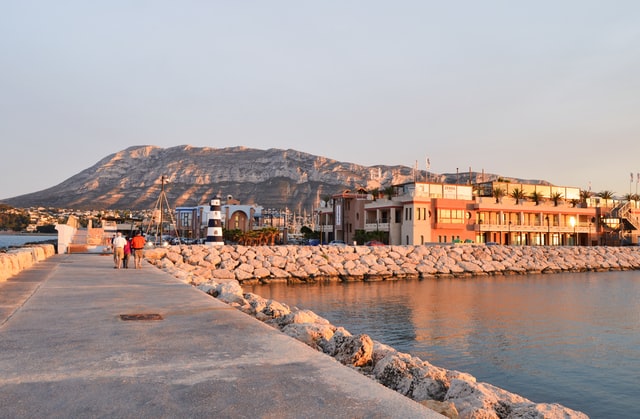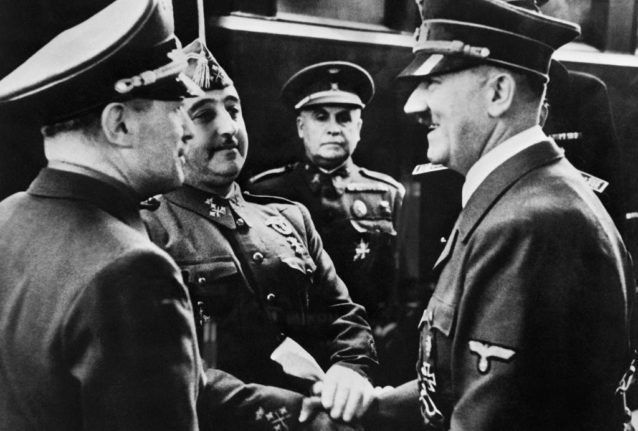Dénia, a small upmarket Costa Blanca port town on Spain’s easterly Mediterranean coast, is most famous for its golden beaches and lively street life.
If you’ve visited, you might’ve taken a stroll through the quaint town up to its castle, overlooking the picturesque marina, or seen the Roman ruins in its museum.
What you might not have realised is that that following the Second World War, Dénia became not only a place of transit for Nazis fleeing Europe (known as a ‘ratline’) but a place of safe haven for many who were allowed to make a home and enjoy their retirement there.
In reality, Dénia’s crystal clear waters have a much murkier past that reveals the ease with wich Nazis settled on Spain’s costas, and the uncomfortable relationship between Franco’s Spain and the Third Reich.
READ MORE: Why Spain is still in the wrong time zone because of Hitler

Costa Blanca, Nazi retirement home?
The Costa Blanca is one of the most sought-after and visited tourist spots in the world. So much so, it seems, that even former Nazis agreed.
Dénia was, for example, the chosen destination of Gerhard Bremer, a high ranking Sturmbannführer in the Waffen SS who was awarded, among a whole host of medals and awards, the Knight’s Cross of the Iron Cross – an accolade only awarded for a serious commitment to Nazi Germany.
After being convicted at the Nuremberg trials, Bremer lived happily in Dénia until his death in 1989, becoming a local businessman and building bungalows and hotels during the birth of tourism on the Costa Blanca.
Bremer and his family were reportedly integrated into the community, with his children attending local schools.
In fact, some Nazis were so comfortable in Spain that many, although remaining discreet of course, never felt the need to renounce their Nazi ideology.
According to Spanish historian José Muñoz, every April 20th, a group of Germans met at the Finita restaurant in Dénia to celebrate Hitler’s birth.
“They did it in a discreet way, a small group of people during the week, not with a party open to the whole town,” he told Spanish website Newtrawl, “they were not idiots”.
READ MORE: Spain seeks return of Nazi gifts ‘proving’ Aryan origins
Another of the first to arrive on the Costa Blanca was Johannes Bernhardt, an honourary general of the SS and businessman who had supplied weapons to Franco, who then rewarded him with Spanish nationality in order to prevent his deportation.
According to historian Stanley G. Payne, “Bernhardt lived discreetly between Madrid and Dénia, without integrating with the locals. In 1953, he left for Argentina.
A third prominent Nazi in Dénia was Anton Galler, alleged by the Italian government to be the commander of the Nazi army responsible for a massacre at Sant’Anna. He lived in Dénia for the rest of his life and was buried there in 1995.
It is also believed that the notorious Otto Skorzeny, the man who organised the mission to rescue Benito Mussolini from captivity in September 1943 and who was nicknamed ‘the most dangerous man in Spain’, also lived on the Costa Blanca.

Nazis in other parts of Spain
These notable examples of known high-ranking Nazis in Dénia are just a handful of hundreds of suspected Nazis that made their homes in Spain following the war.
And it was no secret; in 1947 the United States wrote to Franco with a list of 104 people suspected of being Nazis, or at least connected to the Nazi party, who were on Spanish territory.
Their initial list was as many as 1,600 names, although ultimately the Americans focused on the 104 most notorious names on the list for extradition.
But perhaps former high-ranking Nazis making their home in Spain didn’t come as that much of a surprise to the British intelligence services.
During the war, many in the British establishment worried about Spanish sympathies towards Nazi Germany, so much so that MI6 bribed top Spanish officials with bribes equivalent to €179 million in order to maintain the country’s neutrality.
Infamous Belgian Nazi Léon Degrelle made a home in Málaga, on the Costa del Sol, and in this case, went to no great lengths to hide his identity. After relocating to Málaga with the help of the Spanish government and keeping a low profile for a few years, Degrelle became an increasingly public figure in the 1960s.
He socialised with other Nazis hiding out in Spain, including Austrian SS coronel Otto Skorzeny, and even wore his SS uniform to his daughter’s wedding in1969.
After diplomatic tensions between Spain and Belgium throughout the 1960’s and 1970’s, Degrelle took Spanish citizenship and lived very comfortably in Málaga having done well financially because his construction company built American airbases in Spain, incredibly, under his real name.
Degrelle felt so comfortable in Spain, in fact, that he attended a centenary celebration of Hitler’s birthday in Madrid in 1989.
As for Skorzeny, who wasn’t so happy to also be nicknamed Scarface, in an interview with the Daily Express in 1952 he said: “I finally feel free in Spain, I can remove my mask and don’t have any reasons to live in secret”.
There are hundreds more Nazis and Nazi sympathisers who found a safe haven in Francoist Spain, from the Basque Country to Barcelona and Mallorca, living the rest of their lives in peace under the Spanish sun, despite the crimes they committed.
If you wish to delve further into the history of the Nazis in Spain, there are several books offering far more detail on the matter, as well as the 2021 Spanish-Belgian film The Replacement (trailer below) or the Spanish series Jaguar.




 Please whitelist us to continue reading.
Please whitelist us to continue reading.
Member comments